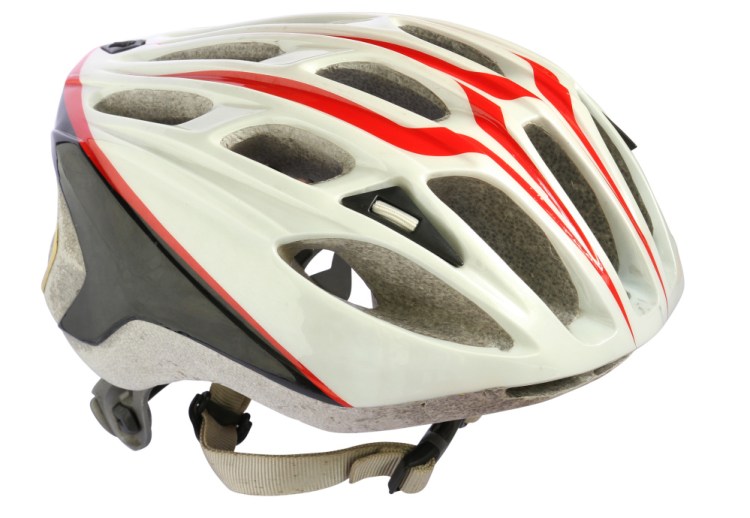EDITOR’S NOTE: After this week, Leg Work will take a short break. When it returns it will become a monthly column.
Whenever people try to ride in my car without buckling their seat belts, an annoying beep reminds them to do so. I wish bicycles had a similar warning system to remind people to wear helmets.
While helmets won’t protect cyclists from all injuries, wearing one is the most important way that you can reduce your risk of head injuries from a crash, according to the National Highway Traffic Safety Administration. The Insurance Institute for Highway Safety reports that helmet use can lower the risk of head injuries in bicycle crashes by an estimated 50 percent. I cringe whenever I see someone riding without one – especially a parent who has buckled up the children but doesn’t see the need to set a good example.
I’ve heard a lot of buzz recently about helmets with multidirectional impact protection system technology. That got me wondering whether this new type of helmet really is safer, thus justifying the higher cost.
This column will delve into that topic and others related to helmets. You’ll get an overview of how to fit them, when to replace them and how to make helmets pay for themselves.
What is MIPS technology and why are some people embracing it?
When cyclists crash, they often hit their heads at an angle. The rotational force from such a crash can cause brain injuries such as concussions. MIPS helmets have an extra layer between the shell and liner that is designed to slide relative to the head, thus providing more protection.
Work on MIPS technology began more than 20 years ago. A Swedish company, MIPS AB, has developed this new type of helmet for horseback riding and snow sports as well as bicycling. The least expensive MIPS helmet that I found on Amazon.com sold for $51, or twice the price of their cheapest regular helmet.
While a study on the MIPS website touts the effectiveness of the helmets in protecting against rotational force, not all research bears that out.
The Bicycle Helmet Safety Institute is a small Virginia-based nonprofit that serves as a clearinghouse for information about helmets. The institute says on its website that MIPS technology is still unproven.
Erik da Silva is program coordinator for the Maine Safe Routes to School program and the Maine Bicycle and Pedestrian Safety Education program. He said, “The studies vary from very conclusive evidence to none as to whether the (MIPS) technology really improves safety – but no one would say it worsens safety.”
“If one can afford the extra premium,” da Silva continued, “then absolutely go for MIPS.” He added that wearing a non-MIPS helmet is much safer than no helmet at all.
Are there other safety differences between bicycle helmets?
The Consumer Product Safety Commission sets basic standards for all bicycle helmets that are designed to protect against traumatic brain injury and death.
Consumer Reports tested 35 bicycle helmets to see how they held up after being dropped at 7 and 14 miles per hour on the front, crown, back and side. The magazine also tested the strength of the chin straps and buckles as well as other features, such as how easily they can be fit. The magazine’s online buying guide recommends 18 models ranging in price from $20 to $220, including four with MIPS technology.
The Bicycle Helmet Safety Institute did its own tests of bicycle helmets for safety features. The group’s report on 2016 helmets concludes, “We have tested a sample of cheap and expensive helmets and found no real performance differences by price. We recommend looking for a helmet that fits you well and has a rounded, smooth exterior with no major snag points.”
When should helmets be replaced?
Since helmets break down over time, the Bicycle Coalition of Maine recommends that they be replaced about every five years. Helmets also should be replaced if you’ve been in a crash, if the shell is cracked or if the helmet no longer fits properly.
How do you fit a helmet?
Choose a helmet that fits you snugly. Without buckling it, shake your head; it shouldn’t move much.
The helmet should be level on your head and low on your forehead. You should be able to see the front edge when you look up. Move the strap sliders to make V shapes around each ear, with the sliders slightly in front of your ears. When you fasten the chin buckle, you should be able to fit only one or two fingers under the strap, and the helmet should feel tight when you yawn.
A video on the website of The League of American Bicyclists shows you how to fit it.
How can you make your helmet pay for itself?
Buy a Bicycle Benefits sticker for $5 and put it on your helmet. That entitles you to free donuts, lettuce, game tokens, wine, cookies and other delicious treats at businesses in Greater Portland, plus discounts at many stores and restaurants. I guarantee that the sticker will quickly pay for itself.
Shoshana Hoose is a freelance writer who walks and bicycles in Greater Portland and beyond. Contact her at shoshanahoose@gmail.com
Send questions/comments to the editors.


